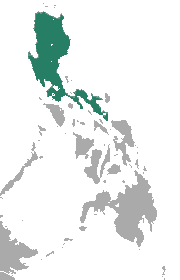 W
WThe Mindanao pygmy fruit bat is a species of megabat in the family Pteropodidae. It is monotypic within the genus Alionycteris. It is endemic to the Philippines. Its natural habitat is subtropical or tropical dry forests. It is threatened by habitat loss. It is a high-elevation specialist which is either scarce or overtaken by tourist hotspots. As a result, this species may be seeking new elevated habitats likely in the southern region of the Philippines and along the islands of Sulawesi as well.
 W
WGilliard's flying fox is a species of flying fox in the family Pteropodidae. In Spanish, the common name is zorro volador de Gilliard. It is endemic to Papua New Guinea. It is known from only three specimens.
 W
WThe Luzon fruit bat is a species of megabat in the family Pteropodidae. It is monotypic within the genus Otopteropus. It is endemic to the Philippines. Its natural habitat is subtropical or tropical dry forest. It is threatened by habitat loss.
 W
WMatthey's mouse is a species of rodent in the family Muridae.
 W
WThe Mindanao pygmy fruit bat is a species of megabat in the family Pteropodidae. It is monotypic within the genus Alionycteris. It is endemic to the Philippines. Its natural habitat is subtropical or tropical dry forests. It is threatened by habitat loss. It is a high-elevation specialist which is either scarce or overtaken by tourist hotspots. As a result, this species may be seeking new elevated habitats likely in the southern region of the Philippines and along the islands of Sulawesi as well.
 W
WMatthey's mouse is a species of rodent in the family Muridae.
 W
WTate's shrew rat is a species of rodent in the family Muridae. It is found only in central Sulawesi, Indonesia, where it has been recorded on Mount Latimodjong, Mount Tokala, and Mount Nokilalaki. The species is named after American zoologist George Henry Hamilton Tate.
 W
WTate's shrew rat is a species of rodent in the family Muridae. It is found only in central Sulawesi, Indonesia, where it has been recorded on Mount Latimodjong, Mount Tokala, and Mount Nokilalaki. The species is named after American zoologist George Henry Hamilton Tate.